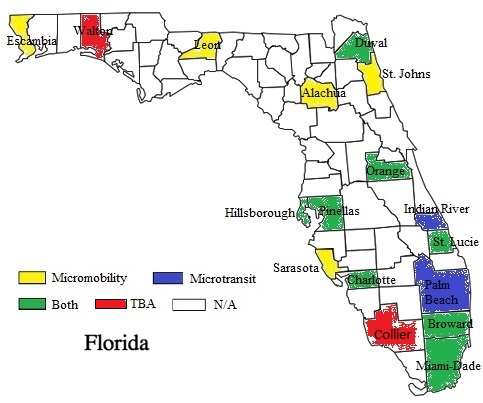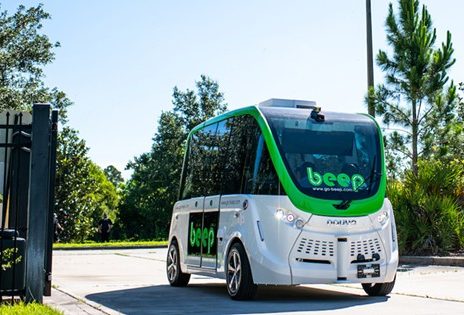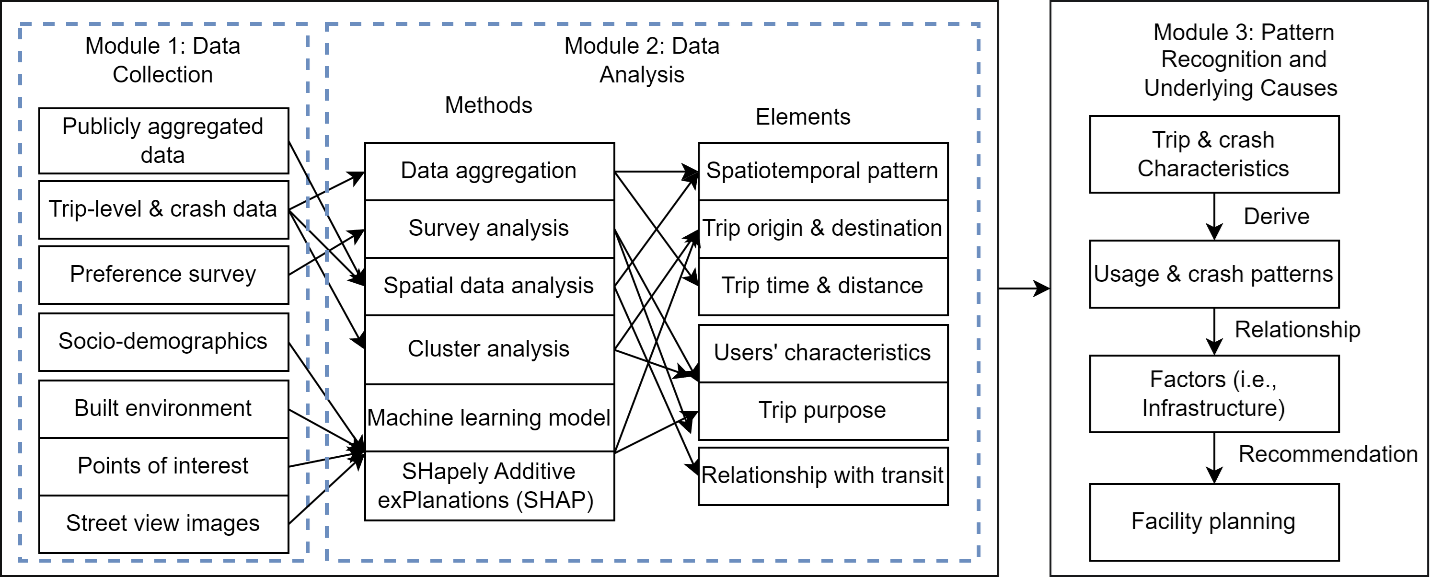Overview
Microtransit and Micromobility are two emerging modes of transportation to provide nearby commuters and residents with an alternative micro-mobility option, particularly over first mile and last mile. One of the design goals of microtransit and micromobility systems is to extend the geographical and demographic reach that the existing public transit network cannot cover. In this track, I aim to investigate the impact of microtransit and micromobility systems on transportation landscape and urban mobility:
Usage Pattern Analysis
Demand Modelling & Prediction
Relationship with Public Transit
Transportation Infrastructure Planning
Microtransit & Micromobility System Evaluation
Research Project
| Microtransit and Micromobility Inventory in the State of Florida |
Examining Data Needs and Implementation Process of AV-based Microtransit Service: A Case Study in Lake Nona |
 |
 |
| Inventory all forms of microtransit and micromobility in Florida, map the geofenced service areas, and identify their relationship, if any, with transit agencies |
Develop a framework for examining various aspects of the AV-based microtransit system, including policy and government support, infrastructure and technology, service and management, financial sustainability, ridership, and community impact. |
| Assessment of Modeling Framework for Micromobility |
 |
| Develop a modeling framework for micromobility analytics that integrates survey analysis, spatial data analysis, and machine learning to understand their usage patterns, crash patterns, and relationships with public transit in Florida. |
Publications
Journal Papers
- Lu, K., Peng, Z. (2025). AI-Driven Approach to Optimize and Automate Shared Micromobility System Planning and Operation (Dissertation). University of Florida
- Lu, K., Liu, Y., Peng, Z. (2025). Assessing the Impacts of Transit Systems and Urban Street Features on Bike-Sharing Ridership: A Graph-based Spatiotemporal Analysis and Prediction Model. Journal of Transport Geography, 128, 104356 [Text].
- Lu, K., Liu, Y., Peng, Z. (2025). Unraveling Urban Bike-sharing Dynamics: Spatiotemporal Imbalances in Bike Rentals and Returns in Washington D.C. Cities, 162, 105967 [Text].
- Liu, Y., Lu, K., Peng, Z., & Zhai, W. (2024). Autonomous Shuttle Acceptance in an American Suburban Context: A Revealed Preference Study in Lake Nona, Florida. Travel Behaviour and Society, 37, 100865 [Text].
- Lu, K., Liu, Y., Peng, Z. (2025). Spatial Dynamics of Campus-Centric Micromobility: Shared Dockless Scooter Usage in University vs. Non-University Towns. Transportation Research Part D: Transport and Environment. (Under Review)
- Lu, K., Liu, Y., Peng, Z. (2025). Leveraging Shared Micromobility to Boost Transit Accessibility and Ridership: Evidence from Florida Cities on Multimodal Integration. Travel Behaviour and Society. (Under Review)
- Lu, K., Peng, Z. (2025). Impact of Shared Micromobility System Sizes on Usage Patterns and Their Planning Implications: A Meta-Analysis of 52 U.S. Cities. Journal of the American Planning Association. (Under Review)
Presentations & Talks
- 2025.01: Transportation Research Board 104th Annual Meeting. Integrating Public Transit Effects and Street View Imagery into a Dynamic Spatiotemporal Graph-based Machine Learning Model for Predicting Bike-sharing Ridership. Washington D.C., USA.
- 2024.11: Association of Collegiate Schools of Planning (ACSP) Conference. Impact of Shared Micromobility System Sizes on Usage Patterns: Planning Implications. Seattle, WA, USA.
- 2024.07: The 18th International Association for China Planning (IACP) Conference. Impact of Shared Micromobility System Sizes on Usage Patterns and its Planning Implications. Hangzhou, China.
- 2024.06: Guest Lecture at Chang’an University. Integrating Public Transit Effects and Street View Imagery into a Dynamic Spatiotemporal Graph-Based Machine Learning Model for Analyzing and Predicting Bike-Sharing Ridership. Xi’an, China.
- 2024.01: Transportation Research Board 103rd Annual Meeting. Demystifying the Spatiotemporal Heterogeneity of Rental-Return Imbalance on Bike-Sharing Systems: A Bayesian Additive Regression Trees (BART) Model. Washington D.C., USA.
- 2023.07: The 17th International Association for China Planning (IACP) Conference. Using Origin-Destination Flow Graph and Public Transit Information to Enhance Short-Term Ridership Prediction in Bike-Sharing Systems. Tianjin, China.


